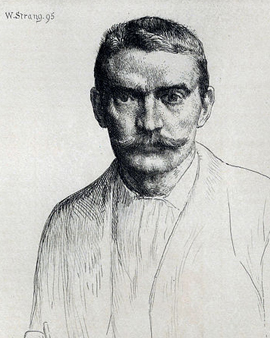William Strang (1859 - 1921) was born in Dumbarton (Scotland) as the son of master builder Peter Strang and the daughter of a founding member of a shipbuilding company. After graduating from Dumbarton Academy and working for about a year as an office clerk in the family business, he was finally allowed to move to London to study art. At the age of 17 he began his education at the Slade School of Art in London. His most important teacher and greatest influencer was the realism painter Alphonse Legros. Strang excelled in Legro's courses in such a way that after his studies he was allowed to work as an assistant in his class for about two years. Strang described his old master Legros as "the greatest teacher that ever lived, because he is the greatest artist that ever taught".
In the first 20 years of his career Strang mainly worked as an etcher and became internationally famous. Although he also painted during this time, he did not publish his first pictures until the early 1890s. In the following years he increasingly devoted himself to portrait painting. By 1904 he had finally established himself as a portraitist and was able to earn a good income. Between 1898 and 1909 he drew over 500 portraits. Strang was also inspired by Rembrandt and created a large number of self-portraits in the course of his career. In addition, Strang's choice of subjects was extremely diverse. He dealt with landscape scenes, but also with motifs ranging from fantastic to macabre, as in the series "The Deeds of Death". In the tradition of the old masters such as Rembrandt or Dürer, whom he greatly respected, he also devotedly dealt with biblical motifs. These include works like "The Temptation" or "The Flagellation".
Although William Strang came from a comparatively wealthy background, he identified himself with the working class throughout his life and tried to represent their concerns in his paintings. He showed this either directly, by showing very realistic depictions of poverty, as in "The Cause of Poverty", or indirectly and on a psychological level, as in "Grotesque". Strang married in 1885 Agnes McSymon, who also came from Dumbarton. With her he had five children. Two of his sons, Ian and David, also became artists.
×





.jpg)
.jpg)
.jpg)
.jpg)
 - (MeisterDrucke-126088).jpg)
 - (MeisterDrucke-126088).jpg)
.jpg)
.jpg)
.jpg)
.jpg)
.jpg)
.jpg)
 1919 - (MeisterDrucke-280063).jpg)
 1919 - (MeisterDrucke-280063).jpg)
.jpg)
.jpg)
.jpg)
.jpg)
 - (MeisterDrucke-247988).jpg)
 - (MeisterDrucke-247988).jpg)
.jpg)
.jpg)
.jpg)
.jpg)
.jpg)
.jpg)
.jpg)
.jpg)
.jpg)
.jpg)
.jpg)
.jpg)
.jpg)
.jpg)
.jpg)
.jpg)
.jpg)
.jpg)
.jpg)
.jpg)
.jpg)
.jpg)
.jpg)
.jpg)
.jpg)
.jpg)
.jpg)
.jpg)
.jpg)
.jpg)
.jpg)
.jpg)
.jpg)
.jpg)
.jpg)
.jpg)
.jpg)
.jpg)
.jpg)
.jpg)
.jpg)
.jpg)
.jpg)
.jpg)
.jpg)
.jpg)
.jpg)
.jpg)
.jpg)
.jpg)
_-_(MeisterDrucke-300735).jpg)
_-_(MeisterDrucke-300735).jpg)
.jpg)
.jpg)
.jpg)
.jpg)
.jpg)
.jpg)
.jpg)
.jpg)
.jpg)
.jpg)
 1903 (charcoal - (MeisterDrucke-267961).jpg)
 1903 (charcoal - (MeisterDrucke-267961).jpg)
.jpg)
.jpg)
.jpg)
.jpg)
.jpg)
.jpg)
.jpg)
.jpg)
.jpg)
.jpg)
.jpg)
.jpg)
.jpg)
.jpg)
.jpg)
.jpg)
.jpg)
.jpg)
.jpg)
.jpg)
.jpg)
.jpg)
.jpg)
.jpg)
.jpg)
.jpg)
.jpg)
.jpg)
_-_(MeisterDrucke-320335).jpg)
_-_(MeisterDrucke-320335).jpg)
.jpg)
.jpg)
.jpg)
.jpg)
.jpg)
.jpg)
.jpg)
.jpg)
.jpg)
.jpg)
 1905 - (MeisterDrucke-271895).jpg)
 1905 - (MeisterDrucke-271895).jpg)
.jpg)
.jpg)
_-_(MeisterDrucke-1113839).jpg)
_-_(MeisterDrucke-1113839).jpg)
.jpg)
.jpg)
.jpg)
.jpg)
.jpg)
.jpg)
.jpg)
.jpg)
.jpg)
.jpg)
_c1918_-_(MeisterDrucke-389224).jpg)
_c1918_-_(MeisterDrucke-389224).jpg)
.jpg)
.jpg)
.jpg)
.jpg)
.jpg)
.jpg)
 1912 - (MeisterDrucke-563657).jpg)
 1912 - (MeisterDrucke-563657).jpg)
.jpg)
.jpg)
.jpg)
.jpg)
.jpg)
.jpg)
.jpg)
.jpg)
_Hungarian_conductor_-_(MeisterDrucke-294808).jpg)
_Hungarian_conductor_-_(MeisterDrucke-294808).jpg)
.jpg)
.jpg)
.jpg)
.jpg)
.jpg)
.jpg)
 - (MeisterDrucke-193704).jpg)
 - (MeisterDrucke-193704).jpg)
.jpg)
.jpg)
.jpg)
.jpg)
.jpg)
.jpg)
.jpg)
.jpg)
.jpg)
.jpg)
.jpg)
.jpg)
_-_(MeisterDrucke-1450024).jpg)
_-_(MeisterDrucke-1450024).jpg)
.jpg)
.jpg)
_-_(MeisterDrucke-315707).jpg)
_-_(MeisterDrucke-315707).jpg)
.jpg)
.jpg)
.jpg)
.jpg)
.jpg)
.jpg)
.jpg)
.jpg)
.jpg)
.jpg)
.jpg)
.jpg)
.jpg)
.jpg)






